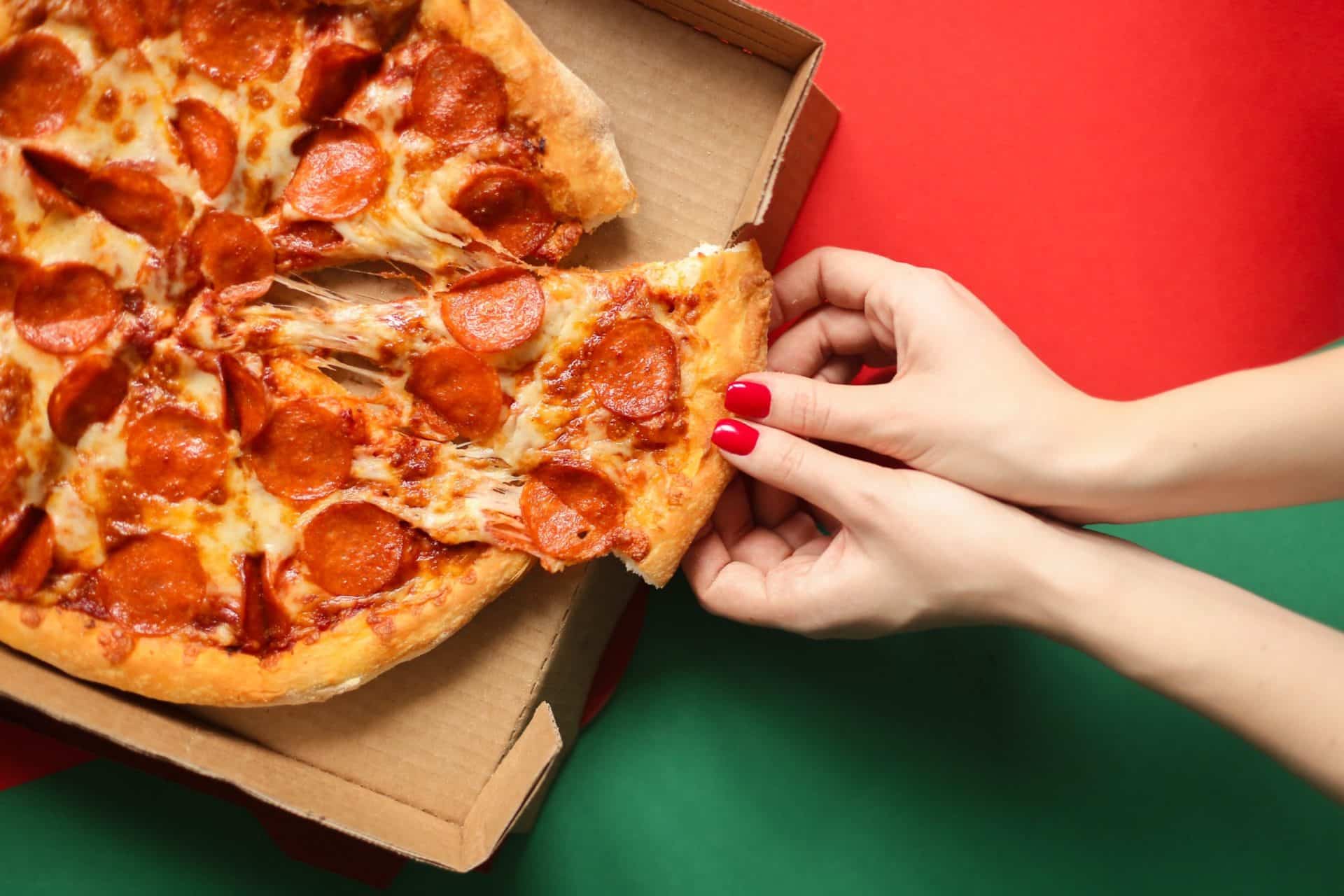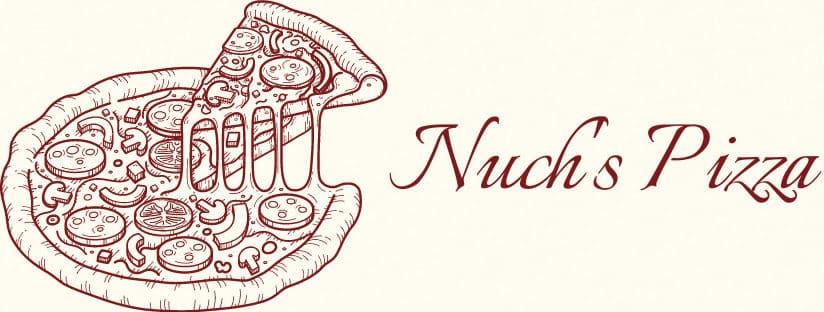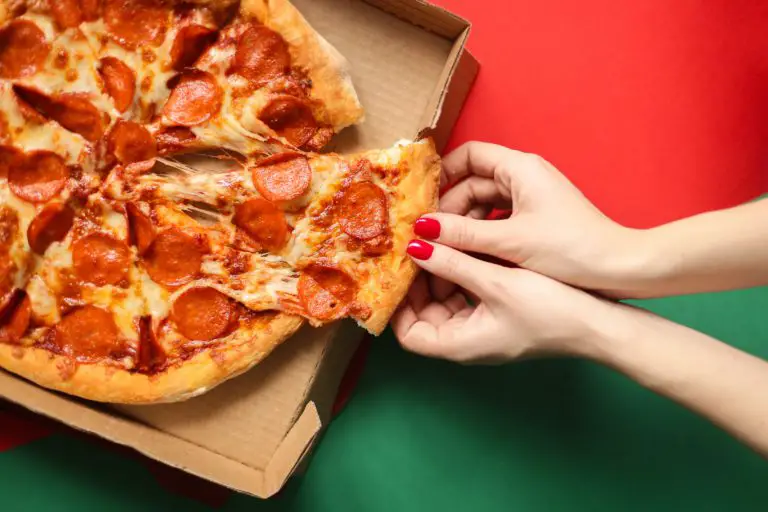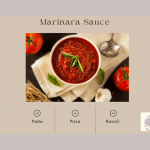Have you ever indulged in a delicious slice of pizza and wondered just how many calories in a slice of pizza? If you have, you’re not alone. Many pizza lovers find themselves asking this question as they feast on their favorite pie. The answer, however, is not as straightforward as one might think. The calorie count of a slice of pizza can differ significantly depending on numerous factors such as crust thickness, the type of cheese used, the toppings, and the size of the slice. That being said, it’s essential to consider the nutritional value alongside the sheer enjoyment of savoring a scrumptious piece of pizza.
This post you might like: Ooni Karu Vs Koda: Which Is Best for Your Pizza Adventures?

What Is a Slice of Pizza?
A slice of pizza is composed of several components, including a crust and a topping. The crust is typically made from wheat flour and yeast, with added ingredients such as oil and sugar to help create the desired texture. On top of this foundation lies the toppings, which can be anything from pepperoni to vegetables or even fruit.
The size of a slice of pizza can vary depending on the size of the pie itself, but a standard slice is usually about one-eighth of an 18-inch pizza. The other sizes of a pizza depend on how many people the pie is meant for, with 12-inch pizzas usually serving two and 16-inch pizzas serving four.
Post you might be interested in: Why Is Thin-Crust Pizza Cut In Squares? Facts For You
The Nutrient Facts of A Pizza Slice
The calorie count of a slice of pizza can range from as low as 150 to as high as 300. This will depend on the type and amount of toppings used, the size of the slice, and the thickness of the crust.
Carbohydrate
A slice of pizza contains about 20 grams of carbohydrates. This number is relatively high compared to other food items, and carbs make up the majority of calories in pizza. However, the number of carbs in a slice of pizza can vary depending on what kind of toppings you add.
Fat
The fat percentage of one-slide pizza is about 20%. Most fats are found in the cheese and crust, with some coming from the toppings as well.
Proteins
A slice of pizza contains about 8 to 12 grams of protein, depending on the type and amount of toppings used. Protein helps our bodies repair muscle tissue and produces essential hormones and enzymes. However, if you consume more proteins than your body needs, they’ll be stored as fat.
Cholesterol
Cholesterol is a slice of pizza that can vary depending on the toppings. If the pizza contains high-fat toppings such as bacon or sausage, then it will have more cholesterol than one with low-fat toppings like vegetables and pineapple. Cholesterol can cause a buildup of plaque in your arteries, leading to an increased risk of heart disease.
Fiber
Fiber is essential for healthy digestion and can help reduce cholesterol levels. Fiber is not usually found in pizza, but if you add toppings like peppers, mushrooms, or spinach to your slice, then you’ll get a little extra fiber.
Does Topping Contribute Calories In a Slice of Pizza?

Sausage
Sausage is a favorite topping of many consumers, however, it contains a lot of fat and calories. Pepperoni is another popular topping, but it’s also high in calories and has a high sodium content.
Cheese
The cheese can range from about 70 to 90 calories per slice depending on the type used. The crust’s thickness and size can also affect calorie counts, as thicker crust pieces contain more calories than thinner ones.
Chicken
Chicken is another popular topping option, but it’s not as calorie-dense as other toppings. Depending on the type of chicken used, one slice can have anywhere from 30 to 60 calories
Salami
Salami has a high number of calories, with one slice containing roughly 70 calories. It also contains high levels of sodium and saturated fat, so it should be consumed in moderation. Overeating salami can have a negative impact on your overall health.
Does Sauce Contribute Calories In a Slice of Pizza?

When it comes to pizza sauce, there are numerous options at your fingertips! From subtle and smooth to bold and flavorful – all with varying calorie levels – the possibilities for indulging in melty, cheesy goodness are truly endless.
Tomato Sauce
Tomato sauce is a common pizza selection, but it does not contribute much to the calorie count of a single slice. The main source of calories in tomato sauce comes from the oil used to make it. Depending on the type of oil used, one tablespoon can contain anywhere from 40 to 120 calories.
Pesto Sauce
Pesto sauce is an excellent alternative to tomato sauce, as it contains fewer calories and fat.The sauce is mostly made up of healthy fats like olive oil, and it contains about 20 calories per tablespoon. It’s a great choice for those looking to watch their calorie intake.
BBQ Sauce
This sauce is a great topping for pizza but should be used sparingly due to its high sugar content. One tablespoon of BBQ sauce usually contains about 50 calories, so it’s best to stick with pesto or tomato sauce when possible.
What Happens To Your Body When Overeating Pizza?
Your body will retain excess calories from eating too much pizza as fat. Over time, this may result in weight gain and a higher chance of developing certain medical disorders, such heart disease. Also, consuming an excessive amount of calorie-dense foods, such as pizza, can cause a buildup of plaque in the arteries, which raises your chance of having a heart attack or stroke.
Digestive issues can also occur if you overeat pizza, as the high-fat content in some toppings can cause stomach discomfort. Additionally, the sodium content from the pizza can cause dehydration, which can lead to headaches and fatigue.
How To Have A Healthy Pizza Slice?
Pizza can be a delicious and nutritious part of your diet if you choose the right ingredients. There are some simple ways to make your slice healthier. You can add more vegetable toppings such as mushrooms, bell peppers, and onion. Because they are low-fat and high in vitamins, minerals, and fiber. A slice of vegetable pizza is a great way to lower the calorie count and boost your nutrient intake.
Choosing the whole grain crust is another way to make your pizza healthier. Whole grains are a good source of fiber, vitamins, and minerals that can help keep you full longer and aid in digestion. There are different types of whole grain crusts like multigrain, wheat, and gluten-free, which you can use to make your pizza even healthier.
If you are a meat lover, choosing lean meats like chicken or turkey is a good option. These types of meat are lower in calories and saturated fat than pepperoni and sausage, so they will not add as much to the total calorie count. According to some research, lean meat contains the essential amino acids to support muscle growth and repair.
Cheese is high in calories, however, it’s a great source of protein and calcium. If you’re looking to cut back on calories, substituting normal cheese for low-fat cheese such as mozzarella or feta is a great way to save calories while still maintaining flavor.
Controlling a portion size is another way to ensure you don’t exceed your calorie limit for the day. One slice of pizza with minimal toppings should contain about 250-300 calories, which can fit into a healthy diet if consumed in moderation.
FAQs
Can People On a Diet Eat a Slice of Pizza?
Yes, people on a diet can still enjoy the occasional slice of pizza. As long as you choose healthy toppings and practice portion control, pizza can fit into your diet plan.
Is A Slice of Thin Crust Pizza More Calories than A Slice of Cheese Pizza?
Not necessarily. Depending on the toppings, a slice of thin-crust pizza can have more or fewer calories than a slice of cheese pizza. It’s best to check the nutrition information for each type before making your choice. How Many Calories Are In A Slice Of Pepperoni Pizza? A single slice of pepperoni.
Are 500 Calories Equal To A Slice of Pizza?
500 calories are not necessarily equal to one slice of pizza. Depending on the toppings and size of the pizza, the caloric content can vary significantly. It’s best to check the nutrition information before eating a slice. If you pick salami as the main topping, the calories can be significantly higher than 500 calories.
Can I Eat Pizza To Lose Weight?
Yes, pizza can be part of a weight-loss diet as long as you choose healthier options and practice portion control. Opt for a whole-wheat crust, limit the cheese, and add plenty of fresh vegetables for a nutritious meal that won’t derail your weight loss goals.
Is Frozen Pizza Fewer Calories Than Fresh Pizza?
Frozen pizzas can contain fewer calories than fresh pizzas. Generally, frozen pizzas are smaller in size, and the servings are pre-portioned. However, this varies from brand to brand, so it’s best to check the labels before you buy.
Conclusion
In conclusion, understanding how many calories are in items you eat everyday is necessary for your health and diet. We hope this article has been helpful to answer the question of how many calories in a slice of pizza, so that you can make healthier decisions for yourself and be more aware of what you’re eating as well as how much. We want to wish you luck on your journey towards improved health and well being.

Iris Harper is a professional writer and restaurant set up consultant. She has over 10 years of experience in the food industry, and loves providing her clients with top-quality service. Her food reviews are highly sought after, as she has a knack for discovering new and delicious pizza creations.







